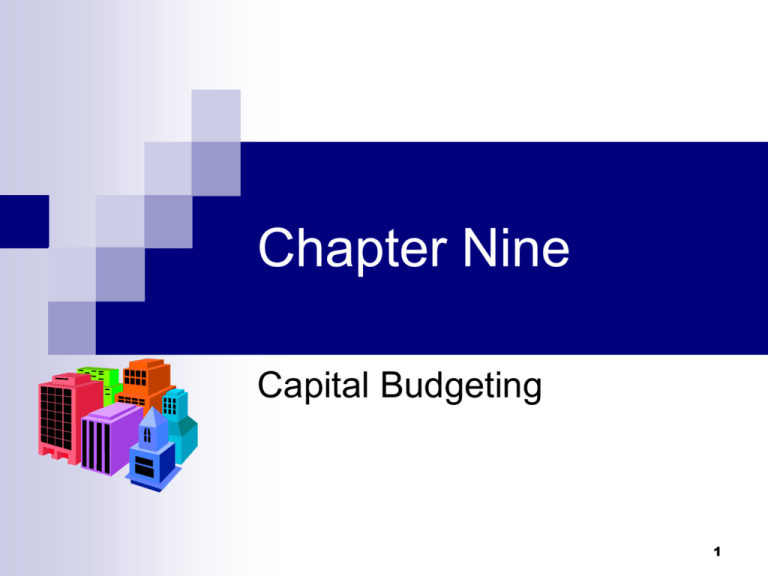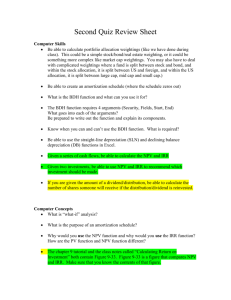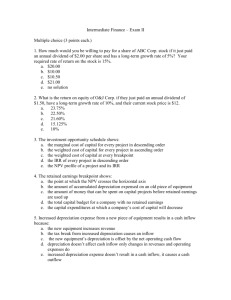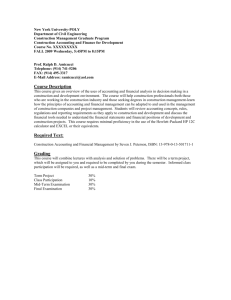Nine
advertisement

Chapter Nine Capital Budgeting 1 Capital Budgeting Decisions require sizable commitments of cash. are expected to generate returns that will last more than one year. involve time value of money. 2 Importance of Capital Budgeting Decisions Capital budgeting decisions commit companies to courses of action. The success or failure of a particular strategy, or even of the company itself, can hinge on one or a series of such decisions. 3 Importance of Capital Budgeting Decisions (continued) In addition, capital budgeting decisions are generally riskier than short-term ones for the following reasons: The company expects to recoup its investment over a longer period. Reversing a capital budgeting decision is much more difficult than reversing a shortterm decision. 4 Types of Capital Budgeting Decisions Investments made to further strategic goals Investments made to increase capacity or reduce costs Investments made for non-financial reasons Investments mandated by law or policy 5 Cost of Capital Cost of capital is the cost, expressed as a percentage, of obtaining the money needed to operate the company. Capital is obtained from two sources, creditors and owners, corresponding to divisions of liabilities and owners’ equity on the balance sheet. 6 Weighted Average Cost of Capital Average costs of debt and equity components Example - debt with after tax cost of 5% is 40% of capital structure and equity with after cost of 15% is 60% of capital structure Cost of capital is: 40% * 5% = 60% * 15% = Total 2% 9% 11% 7 Cutoff Rate Because of the practical difficulties of determining cost of capital, managers might simply use their judgment to set a minimum acceptable rate, called a cutoff rate, hurdle rate, or target rate. 8 The Capital Budgeting Decision Models Discounted Cash Flow (DCF) Techniques: Net present value (NPV) Internal rate of return (IRR) Nondiscounted Cash Flow Techniques Payback Book period rate of return 9 Net Present Value Method The net present value method (NPV) uses the minimum acceptable rate to find the present value (PV) of the future returns and compares that value with the cost of the investment. 10 Internal Rate of Return Method The internal rate of return method (IRR) finds the rate of return associated with the project and compares that rate with the minimum acceptable rate. NPV = PV of future returns Cost of the investment 11 Decision Rules Under the NPV method, a project having a positive NPV should be accepted; others should be rejected. Under the IRR method, a project having an IRR greater than the company’s cost of capital should be accepted. 12 Purchase of Machine Example Machine costs $60,000 Sell 3,000 units per year at $14 for the next 5 years Variable costs are $5 per unit Annual cash fixed costs are $5,000 Cutoff rate of 12 percent 13 Annual Incremental Cash Inflows Annual Cash Flows Revenues ($14 x 3,000) Variable costs ($5 x 3,000) Contribution margin ($9 x 3,000) Cash fixed costs Expected increase in net cash $42,000 15,000 $27,000 5,000 $22,000 14 Net Present Value Example Expected increase in net cash $22,000 Present value factor (PVA 5 12%) x 3.6048 Present value of future cash flows $79,306 Investment required Net present value 60,000 $19,306 15 Internal Rate of Return Factor = PV of future flows/Annual cash flows Factor = $60,000/$22,000 = 2.727 The 2.727 corresponds to an interest rate between 20 and 30 percent when the number of periods is five. The IRR is about 25%. 16 Taxes and Depreciation Additional information: Tax rate is 40 percent. Straight-line depreciation is used. 17 Annual After-Tax Cash Inflows Revenues Cash expenses Cash inflow before taxes Depreciation Income Cash Flow $42,000 $42,000 20,000 20,000 $22,000 $22,000 12,000 Increase in taxable income $10,000 Income taxes (40 percent) 4,000 Net Income $6,000 Depreciation 12,000 Net increase in cash inflow $18,000 4,000 $18,000 18 Net Present Value of After-Tax Example Expected increase in net cash inflows $18,000 Present value factor x 3.6048 Present value of future cash flows $64,887 Investment required 60,000 Net present value $4,887 19 Internal Rate of Return Factor = PV of future flows/Annual cash flows Factor = $60,000/$18,000 = 3.333 The 3.333 corresponds to an interest rate between 15 and 16 percent when the number of periods is five. The IRR is between 15 and 16 percent. 20 Payback Period Payback Period = Investment /Annual cash return = $60,000/$18,000 = 3.333 years 21 Book Rate of Return Average book rate of return = Net income/Average book investment = $6,000/($60,000/2) = 20 percent Net income is cash flow less depreciation Average investment is (investment +residual)/2 This is the only method discussed that does not use cash flows. 22 Tax Depreciation For Tax, depreciation is computed using either the Modified Accelerated Cost Recovery System (MACRS) or optional straight line. MACRS gives rapid depreciation according to tables published by the IRS Optional straight line uses a shorter life than the actual life and a half year convention Tax deprecation will almost always end up with uneven cash flows. 23 Cash Flow Problem Information - A company is offered an 8 year contract that will yield an annual gross cash flow of $450,000 with cash expenses of $261,500. Working capital investment is $90,000, and machinery costing $700,000 is required. The equipment is 5 year property for MACRS depreciation, and has a useful life of 9 years, but will be sold at the end of year 8 for $25,000. The tax rate is 30% and the cost of capital is 14%. 24 Calculating Annual Cash Flow Year Equipment Cost Working Capital Cash Flow Cum Cash Flow 0 -700000 -90000 -790000 -790000 25 Calculating Cash Flows Year Gross Rev Cash Expense Less Depreciation Plus Salvage Taxable Income Tax Net DEP Working Capital Cash Flow 1 2 3, 4, 5 450000 450000 450000 -261500 -261500 -261500 -140000 -224000 -134400 48500 -14550 33950 140000 -35500 10650 -24850 224000 54100 -16230 37870 134400 173950 199150 172270 26 Final Cash Flows Gross Rev Cash Expense Less Depreciation Plus Salvage Taxable Income Tax Net DEP Working Capital Cash Flow 6 7 8 450000 450000 450000 -261500 -261500 -261500 -40600 25000 147900 188500 213500 -44370 -56550 -64050 103530 131950 149450 40600 0 0 90000 144130 131950 239450 27 MACRS Example MACRS Example Year 0 Equipment Cost 1 2 3 4 5 6 7 8 450000 -261500 -140000 450000 -261500 -224000 450000 -261500 -134400 450000 -261500 -80500 450000 -261500 -80500 450000 -261500 -40600 450000 -261500 450000 -261500 -700000 Gross Rev cash expense Less Depreciation Plus Salvage Taxable Income Tax Net DEP Working -90000 Capital Cash Flow -790000 Cum Cash -790000 Flow Net Present Value Internal rate of ret 48500 -14550 33950 140000 -35500 10650 -24850 224000 54100 -16230 37870 134400 108000 -32400 75600 80500 108000 -32400 75600 80500 147900 -44370 103530 40600 188500 -56550 131950 0 25000 213500 -64050 149450 0 90000 173950 -616050 199150 -416900 172270 -244630 156100 -88530 156100 67570 144130 211700 131950 343650 239450 583100 $7,939 Do this using NPV function 14.30% Do this using IRR function 28 Straight Line Example Year Equipment Cost Gross Rev Cash Expense Less Depreciation Plus Salvage Taxable Income Tax Net DEP Working Capital Cash Flow Cum Cash Flow Net Present Value Internal rate of ret 0 Capital Budgeting Example Using Straight Line 1 2 3 4 5 6 7 8 450000 -261500 -70000 450000 -261500 450000 -261500 -700000 450000 -261500 -70000 118500 -35550 82950 70000 -90000 -790000 -790000 450000 -261500 -140000 48500 -14550 33950 140000 450000 -261500 -140000 48500 -14550 33950 140000 450000 -261500 -140000 450000 -261500 -140000 48500 -14550 33950 140000 48500 -14550 33950 140000 118500 -35550 82950 70000 188500 -56550 131950 0 152950 173950 173950 173950 -637050 -463100 -289150 -115200 ($4,881) Do this using NPV function 13.82% Do this using IRR function 173950 58750 152950 211700 131950 343650 25000 213500 -64050 149450 0 90000 239450 583100 29






